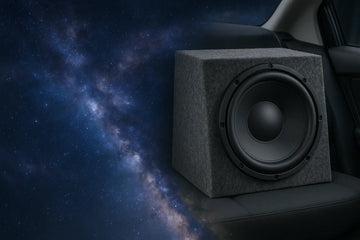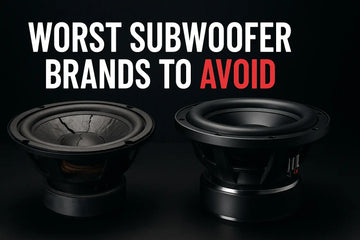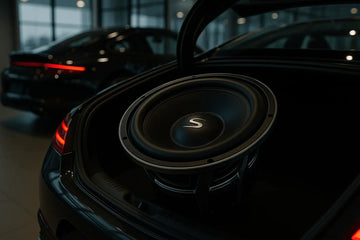What Does a Subwoofer Do? Complete 2025 Guide
Explore the essential role of subwoofers in modern audio systems, from reproducing low frequencies to enhancing your listening experience with deep, powerful bass.
Bass Enhancement
Car Audio
Home Theater
Understanding Bass Reproduction in Modern Audio
A subwoofer is a specialized loudspeaker designed to reproduce low-frequency sounds, typically ranging from 20Hz to 200Hz. These powerful components handle bass frequencies that regular speakers cannot efficiently produce, creating the deep, rich sound foundation essential for immersive audio experiences.
Modern subwoofers including both active and passive designs utilize large drivers and sophisticated amplification to deliver accurate bass reproduction. Whether you're enjoying action movies with thunderous explosions or music with deep electronic beats, subwoofers provide the low-end frequencies that make audio feel complete and emotionally engaging.
Frequency Range
20Hz - 200Hz bass reproduction
Power Handling
High-power amplification support
Audio Enhancement
Immersive listening experience
Evolution of Bass Technology: 1920s to 2025
Early Development (1920s-1950s)
The first bass reproduction systems emerged from pipe organs and early cinema sound systems, focusing on creating deep low-frequency effects for enhanced audio experiences.
Hi-Fi Revolution (1960s-1980s)
Dedicated low-frequency drivers became essential components of stereo systems, with manufacturers developing specialized enclosures for optimal bass performance.
Digital Integration (1990s-2010s)
Powered subwoofers with built-in amplifiers revolutionized home theater systems, offering precise bass management and seamless integration with high frequencies from main speakers.
Modern Innovation (2020s-2025)
Smart subwoofers including wireless connectivity, room correction technology, and AI-powered optimization deliver unprecedented bass accuracy and user convenience.
Active vs Passive Subwoofer Systems
Active (Powered) Subwoofers
Feature built-in amplification, crossover controls, and phase adjustment. Perfect for plug-and-play installation in home theaters and car audio systems.
- Integrated amplifier and controls
- Optimal power matching
- Easy setup and configuration
Passive Subwoofers
Require external amplification but offer flexibility in system design. Popular in professional audio and custom installations.
- Requires separate amplifier
- Flexible power options
- Professional installation preferred
Pro Tip: For most home users, active subwoofers provide the best balance of performance and convenience, while passive systems excel in professional environments requiring custom amplification.
Bass Frequency Management
Crossover Integration
Seamlessly blends low frequencies with high frequencies from main speakers, typically set between 80-120Hz for optimal performance.
Phase Control
Ensures proper timing alignment between the subwoofer and main speakers, preventing cancellation and enhancing bass impact.
Room Correction
Modern systems include EQ adjustment to compensate for room acoustics and optimize bass response at your listening position.
Practical Applications in 2025
Home Theater Systems
Essential for reproducing movie sound effects, explosions, and ambient low-frequency content that creates cinematic immersion.
- • Dolby Atmos bass management
- • LFE channel reproduction
- • Room-filling bass presence
Automotive Audio
Overcomes road noise and vehicle acoustics to deliver powerful bass reproduction in challenging mobile environments.
- • Compact enclosure designs
- • High-power efficiency
- • Vibration resistance
Music Production
Critical for accurate monitoring of bass frequencies in recording studios and professional mixing environments.
- • Studio reference monitoring
- • Bass instrument amplification
- • Mix translation verification
How Subwoofers Reproduce Low Frequencies
Driver Technology
Subwoofers utilize large-diameter drivers (typically 8-18 inches) with long excursion capabilities to move substantial air volumes. The cone material, voice coil design, and magnetic structure work together to produce accurate low-frequency reproduction.
Key Components:
- • Cone/Diaphragm: Moves air to create sound waves
- • Voice Coil: Converts electrical energy to motion
- • Magnet Assembly: Provides magnetic field for driver control
- • Suspension: Controls cone movement and centering
Enclosure Design Impact
The cabinet design significantly affects bass response characteristics. Sealed enclosures provide tight, accurate bass, while ported designs offer enhanced efficiency and deeper extension.
Sealed Enclosures
Accurate, controlled bass response with gradual roll-off
Ported Enclosures
Enhanced efficiency and deeper bass extension
Bandpass Designs
Highly efficient within specific frequency range
Optimizing Your Subwoofer Setup
Placement Considerations
Proper placement is crucial for optimal bass performance. Room acoustics, listening position, and interaction with main speakers all influence the ideal subwoofer location.
Corner Placement
Maximizes bass output but may cause boomy response
Front Wall Center
Balanced output with good integration to main speakers
Multiple Subwoofers
Even bass distribution throughout the listening area
Calibration Settings
Proper calibration ensures seamless integration between your subwoofer and main speakers, creating cohesive full-range audio reproduction.
Pro Installation Tip
Use a sound level meter or room correction software to fine-tune your subwoofer's performance. Many modern receivers include automatic calibration systems that measure room acoustics and optimize settings accordingly.
2025 Advanced Subwoofer Technologies
Wireless Connectivity
Modern subwoofers including wireless transmission eliminate the need for long cable runs while maintaining high-fidelity bass reproduction.
AI Room Correction
Intelligent algorithms automatically analyze room acoustics and optimize bass response for your specific listening environment.
App Control
Smartphone applications provide remote control, EQ adjustment, and system monitoring for convenient bass management.
Driver Protection
Advanced limiter circuits prevent driver damage from over-excursion while maintaining clean bass output at high volumes.
Energy Efficiency
Class D amplification and smart power management reduce energy consumption while delivering powerful bass performance.
Compact Design
Innovative driver and enclosure technologies deliver powerful bass from increasingly compact form factors.
Frequently Asked Questions
Do I need a subwoofer if I have full-range speakers?
Yes, even full-range speakers benefit from a dedicated subwoofer. While they may reproduce some bass, a subwoofer handles low frequencies more efficiently, reducing strain on main speakers and providing deeper, more impactful bass response.
What size subwoofer do I need for my room?
Room size influences subwoofer selection. Smaller rooms (under 200 sq ft) work well with 8-10 inch drivers, medium rooms (200-400 sq ft) benefit from 12-inch drivers, while larger spaces may require 15-inch or multiple subwoofers for adequate bass coverage.
Can I connect any subwoofer to my receiver?
Most modern receivers include subwoofer outputs compatible with powered subwoofers. For passive subwoofers, you'll need a separate amplifier. Always check impedance matching and power handling specifications for optimal compatibility and performance.
How do I know if my subwoofer is properly calibrated?
Proper calibration results in seamless integration where you hear enhanced bass without localizing the subwoofer's location. The bass should sound natural and balanced across different types of content, from music to movies.
Transform Your Audio Experience
Understanding how subwoofers enhance your audio system is the first step toward achieving exceptional sound quality. From reproducing deep bass frequencies to creating immersive experiences, subwoofers are essential components of modern audio systems.
Continue Your Audio Journey
Subwoofer Impedance Guide
Learn about impedance matching and power handling for optimal performance.
Read More →Subwoofer Enclosure Design
Discover how enclosure design affects bass response and performance.
Learn More →




